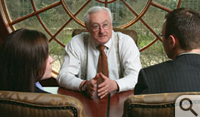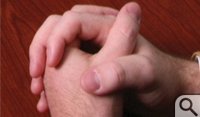The Mentor
He drives down from Jersey to teach young entrepreneurs how to get technology out of the labs and into the markets.
Some people go into a lab, look at the work in progress, and ask “What is it good for?” When Richard Ash goes into a lab, his question is “What else is it good for?”
Ash is clinical professor of entrepreneurship and private equity at William and Mary’s Mason School of Business. He drives down to Williamsburg each week from his home in Princeton, N.J., to preside over entrepreneurship seminars at the Mason School.
An attorney, Ash’s background includes running the financial division at J.P. Morgan and teaching at the University of Virginia’s Darden School of Business. He’s also served as an advisor to NASA and the Department of Energy.
But above all else, Dick Ash is a VC—a venture capitalist. At William and Mary, Ash is an entrepreneurial evangelist, spreading his brand of venture-capital gospel among the ranks of business and law students.
“I want William and Mary to create an entrepreneurship program that’s world-class,” he said. “We started from scratch and now we’ve established an entrepreneurship program that goes from the B.B.A.s to the M.B.A.s.”
Ash takes advantage of a vehicle called Career Acceleration Module, or CAM. The Mason School offers a number of CAMs, which integrate academic and real-world experiences into intensive seven-week programs. There are finance CAMs and marketing CAMs and operations CAMs; Ash runs entrepreneurship CAMs.
Ash hand-picks a few high-performing Mason M.B.A. students each semester to join one of his groups. “I do due diligence on each one of them,” he says. He sorts the group into competitive two- or three-person teams.
Ash brings scientists in from their labs at William and Mary or the Virginia Institute of Marine Science or the U.S. Department of Energy’s Thomas Jefferson National Accelerator Facility. The researchers discuss their discoveries and potential for moving those discoveries into the commercial arena. They meet with the whole group—and privately, with each individual team. The assignment is for each team to create a business plan for bringing the technology into the market. And may the best CAM win.
The questions begin
 After the scientist presents his or her emerging technology, the teams have to start looking into the standard questions. Ash ticks them off on his fingers: “Is there a market there? How big is the market? Is there an ease of entry? How are the intellectual property positions—the IP? As an attorney I can tell you, we focus very heavily on do you have the IP and if not—you better get it.”
After the scientist presents his or her emerging technology, the teams have to start looking into the standard questions. Ash ticks them off on his fingers: “Is there a market there? How big is the market? Is there an ease of entry? How are the intellectual property positions—the IP? As an attorney I can tell you, we focus very heavily on do you have the IP and if not—you better get it.”
Once they understand the nuts and bolts, the students have a couple of challenges to overcome to get through the process. One is overcoming their natural youthful optimism. Ash wants his charges to get enthusiastic, but not over-excited, about the prospects for their program.
“You gotta remember I spent 25, 30 years in venture capitalism and I’ve really pretty much seen the Olympics of misery,” Ash said. “You gotta show me, and I’ve heard every pitch. Yeah, I get excited about something, but then I go and I research the hell out of it.”
Students also have to learn how to work with the people who make the discoveries they’re trying to bring into the market.
“For researchers, scientists, bench technologists, the beauty is writing papers and publishing,” he said, “and very often they’ve missed the chance to nail down their intellectual property because they have published too soon. So, somebody’s got to be watching the intellectual property rights or you could lose it right there.”
Finally, Ash teaches his students the knack of looking past the scientist’s intention.
“You develop a rapport with some researchers and they show you their discovery and tell you about the uniqueness of it all. And you look at it and you tell them, ‘That’s pretty interesting,’” he said. “Now what else will it do?”
Enter the scientist
 One chilly February evening, Ash presided over a freewheeling working-group meeting that was half physics lecture, half entrepreneurial sermon and half brainstorming session. The participants were William and Mary School of Law students mixed with Ash’s M.B.A. students and formed into three competitive teams.
One chilly February evening, Ash presided over a freewheeling working-group meeting that was half physics lecture, half entrepreneurial sermon and half brainstorming session. The participants were William and Mary School of Law students mixed with Ash’s M.B.A. students and formed into three competitive teams.
All three teams were on hand to listen to and ask questions of Gwyn Williams, a scientist from Jefferson Lab in Newport News. Williams had been briefing the three teams on advances made at Jefferson Lab in technology based on terahertz light or T-rays. T-rays are the part of the spectrum between infrared and microwaves. Thanks to a power source developed in part by Williams, the technology shows promise for a number of commercial uses, including the next generation of high-tech security devices.
The three seven-member teams were competing to put together the best business plan for marketing T-ray technology. But first, the business students and law students needed to understand not only the technology, but also the wide variety of working and contractual options available. Ash’s colleague Neal Robinson, an adjunct professor at the law school, helped with a rundown of the contractual menu—CREDA, work-for-others and two types of licenses.
Not only did the teams need to select the most advantageous license or contract with Gwyn Williams, they also couldn’t forget that Williams isn’t a free agent. Ash pointed out that the business plans based on federally funded research, like that going on at Jefferson Lab, must include a provision for Uncle Sam. “You may want to hire the scientist, but the lab may not agree. The government wants money to pay for all this research,” Ash said.
The focus of the session jumped around. Technology, law and business all were discussed, sometimes simultaneously. There were many variations on the Ash theme song: What else will it do? Williams fielded questions about his hopes for seeing his work benefit humanity at large, but mostly about how his T-ray technology works.
“What is spectroscopy? What does that mean?” a student asked.
“Spectroscopy means colors,” Williams explained. “There is a very broad spectrum of colors. Some of them you can’t see with your eye, but you can through spectroscopy in the range of terahertz frequencies.”
Showtime
April 15, tax day, and the three teams reassemble in the Blow Hall lecture room for presentation of their plans. Gwyn Williams is back, along with some colleagues from Jefferson Lab, including Rhonda Scales, legal counsel at the lab, who works with actual tech-transfer licensing deals. The role of Jefferson Lab personnel for the evening was to evaluate the technical, as well as the commercial, feasibility of each of the three plans. Ash and Robinson would deliver verdicts as well.
“Here’s the rules,” Ash called out. “You have twenty minutes to make your pitch. Watch me for arm signals; I’ll let you know when you have ten and five minutes left. Then you’ll have twenty minutes to answer questions and defend. Neal and I have absolute confidence in you. Talk slow and remember—it’s a sales job.”
The first team proposed establishment of a firm called New Wave Technologies, which will seek to manufacture a T-ray quality-control device “similar to a large photocopy machine.” Their plan wass to identify the best markets from broad fields within pharmaceuticals, paper/lumber, food products and the automotive industries.
The second group, hoping to dba as ThzTech, took dead aim at the pharmaceutical markets, identifying niches in quality control and drug discovery and development. They proposed a terahertz-based drug compound analyzer followed by another machine that would mass-scan batches of pharmaceuticals for quality control.
The final pitch was made by a group who identified themselves as TeraScanz, with proposals for medical imaging technology. They presented a plan to partner with scientific labs and university medical centers to use terahertz technology to make instruments for medical imaging.
The judges confer
Each presentation takes place below a projected PowerPoint, team members explaining their plans for capitalization, IP, licensing, marketing, corporate structure and so on. After each presentation there was a round of questions, often pointed, from the Jefferson Lab crew.
“So what you’re saying,” Scales asked one team, “is that Jefferson Lab is going to be empty-handed for the first year of your operation?” The answer was a very quiet yes.
 After the three teams filed out the Jefferson Lab audience conferred and awarded points. Ash joined the deliberations near the end and added his own comments.
After the three teams filed out the Jefferson Lab audience conferred and awarded points. Ash joined the deliberations near the end and added his own comments.
“We saw a lot of naiveté up there this evening,” he said with a smile. One team was decidedly weaker than the other two, but the Jefferson Lab participants and Ash differed on which of the two offered the greatest chance of success.
Failure is not just a featured event in Ash’s Olympics of misery; it’s also a big part of the life of the venture capitalist, the lawyer and the entrepreneur. Ash doesn’t browbeat or patronize but he doesn’t shelter his students from failure, either. His manner with the CAM members is avuncular, but he’s the kind of uncle who teaches nephews and nieces to swim by tossing them in the river.
“I want our students to understand what the real world is like,” Ash said. “A lot of times these new companies go belly up and that’s the way, you know—not everything is good. And they have to learn how to react to various problems.” 
















